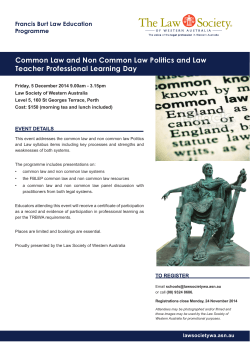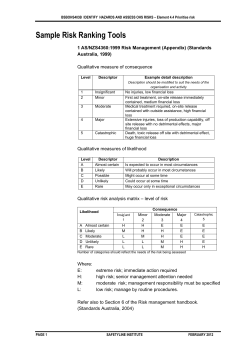
Fluorochemicals in the Environment - Australian Policy Development
Abstract Submission 29-31 October 2014 – Jupiters Casino, Gold Coast, Australia Fluorochemicals in the Environment - Australian Policy Development and International Strategic Directions Dr Jimmy Seow1 1 Department of Environment Regulation, Locked Bag 33, Cloister Square, Perth WA 6850, AUSTRALIA jimmy.seow@der.wa.gov.au Session Fluorchemicals - Contaminants of Emerging Concern, 10 – 10.40 am, Thursday 30 th October 2014. Keywords: Fluorochemicals, PFOS, PFOA, fluorotelomer, firefighting foam policy Abstract Fluorochemicals (such as PFOS, PFOA and fluorotelomers) containing fluorinated carbon chains do not occur naturally in the environment. It is widely used in a whole range of industrial applications from textiles, preservatives, fluoropolymer, surface treatment, food packaging, hydraulic oil, cosmetics, floor wax, polish, paint and lacquer to fire-fighting foams. The impact of fluorochemicals on the environment and human health due to their persistence, bioaccumulation and toxicity (PBT) are now well documented, established and recognised worldwide, in particular in the United States of America (USA), Canada, United Kingdom (UK), Sweden, Norway, Germany and Australia. As a result, firefighting foam users are now using foams with fluorotelomers (6:2 FTS) or foams which are fluorine free (F3). Many countries have now taken steps to ban, curtail or restrict the use of fluorochemicals in firefighting foams. For example, PFOS in firefighting foams is no longer allowed. Fluorochemical manufacturers in the US and Canada have phased out PFOS manufacture and have implemented a Global Stewardship Program to drastically reduce levels of PFOA in products by 2015. Norway and Germany intend to legislate to restrict the use of PFOA. In May 2009, the Stockholm Convention was rectified to ban PFOS production and use of PFOS and its salts; together with perfluorooctane sulphonyl fluoride (PFOSF). PFOS is now restricted under Annex B of the Convention. Foams with fluorotelomers (6:2 FTS) are currently allowed to be used. There are other issues related to use of fluorochemicals that need still to be resolved such as the operational use of foams with fluorochemicals, contaminated sites investigation/ remediation acceptance criteria,and treatment and disposal. In Australia, currently there is no position or policy to address all the above issues and the Queensland Department of Environment and Heritage Protection and the WA Department of Environment Regulation is currently drafting a policy to address it. The policy addresses foam usage, foam environmental acceptable criteria, training foams, contamination site investigation and remediation values and landfill acceptance conditions. 2014 EcoForum c/- Australasian Land & Groundwater Association (ALGA) 40 Hoddle St, Robertson NSW 2577 Ph 1300 789 719 m 0409 531 305 Abstract Submission 29-31 October 2014 – Jupiters Casino, Gold Coast, Australia Speaker Biography Dr Jimmy Seow has a PhD in soil science, geomorphology and catchment management from University of Western Australia and MSc. (Hon) in Earth Sciences from Waikato University New Zealand. Dr Seow has over 30 years’ experience in Environment, Health and Safety and Emergency Management having worked in Government, Oil and Gas, Mining, Environment Consultancy, Environmental and Information Technology and Research. Currently Dr Seow is Manager Pollution Response WA Department of Environment and Regulation. He is responsible for emergency responses to pollution, chemical and Hazmat incidents and emergencies. Dr Seow is also a member of three WA state emergency management committees - WestPlans Hazmat, CBRN and Marine Oil Pollution. In March 2013 Dr Seow published a review paper on fluorochemicals which discussed its environmental impact and legislation and policies on its use, and jointly drafting the policy on Management of Fire Fighting Foam with the Queensland Department of Environment and Heritage Protection. Dr Seow is also an Adjunct Associate Professor at Curtin University WA lecturing on emergency management and Hazmat response, and a Research Fellow at HLP University Malaysia. 2014 EcoForum c/- Australasian Land & Groundwater Association (ALGA) 40 Hoddle St, Robertson NSW 2577 Ph 1300 789 719 m 0409 531 305
© Copyright 2025
















![De Poef Wope [woolen rope] your seat in](http://cdn1.abcdocz.com/store/data/000105306_2-59a13917e66af3eefc367f3fcf9d5673-250x500.png)
